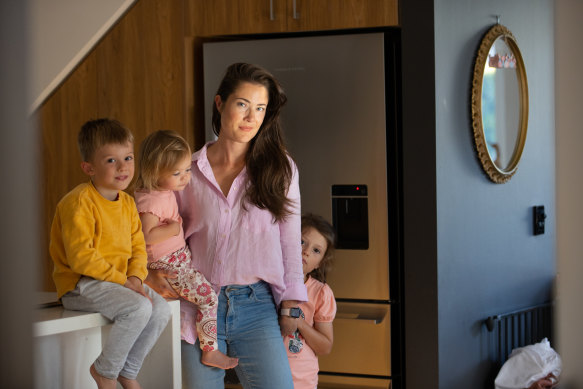By Rachel Clun
Bree Turner would like to work, but the cost of childcare for two children means it doesn’t stack up financially.
“I’m very grateful to be able to stay at home if I want to but … I’d like to contribute. And I feel like basically I’m being told, ‘you can’t work’,” she said.

Bree Turner with her children Kirilly, 7, Brooklyn, 4, and April, 2. Credit: Simon Schluter
Many Australian families are caught in a childcare catch-22. A parent, usually the mother, wants to return to work or study but cannot get subsidised childcare until they already have a job or a course to attend.
And for some families, including Turner’s, it can make little financial sense for one parent to work when the other may be in line for pay bonuses, which can throw out their income estimates, forcing them to repay some of the subsidies they receive.
But despite the hurdles, Turner says there are benefits to working beyond the money earned.
“I also need that adult social interaction and the need to feel like I’m contributing and giving back in some way,” she said.
Scrapping means testing and occupational requirements for childcare subsidies (the activity test) was one of the recommendations of the government’s Women’s Economic Equality Taskforce final report last October. Labor is being urged to get rid of it in its May budget.
Services Australia uses an estimate of a family’s income to work out what childcare subsidy percentage it can receive, which is up to 90 per cent for people earning below $80,000 and gradually tapers to nothing for families earning $530,000 or more.
But the hours of subsidised care families receive can also depend on their “activity level”, which is the number of hours worked each fortnight.
Businesswoman Sam Mostyn, who chaired the Women’s Economic Equality Taskforce, said that could leave parents who were out of work “stranded in a catch-22 process” that prevented them from finding secure jobs because they could not access cheaper childcare to look for employment.
“We would encourage them [the federal government] to do as much of that heavy lifting in this budget as possible because the impact on the economy and for women and for parents, men and women, is so significant,” she said.
The Parenthood’s chief executive, Georgie Dent, said about 126,000 children from low-income households were estimated to miss out on access to quality early childhood education and care because of the activity test requirements.
“Every single child in Australia should be entitled to quality early childhood education and care, in the same way that they are entitled to primary education and secondary education,” she said.
“When you enrol your child at the local primary school, nobody asks how many hours you’re working, or what you earn, or what you don’t earn. There’s just a position available.
“The activity test, I suppose, is one of the most tangible illustrations of how the system is not universal at this stage because it does limit participation among a cohort of children.”
Independent MP Zoe Daniel said those who needed subsidised care the most were more likely to be negatively affected by the activity test requirements. She said the test should be scrapped in the upcoming budget.
“I’m strongly arguing that unlocking women’s economic participation is a win, win, win for the economy, and also for families,” Daniel said.
“Women [and] kids benefit from this, and then you’ll also get that economic boost as well. But I accept that like everything, there’s an upfront cost followed by a long-term benefit.”
Former Chief Executive Women president Sue Morphet said she agreed with the Productivity Commission that good early childhood education and care was three days of free, high-quality care a week as soon as families needed it, with extra days as required at minimal cost.
“Investment in [early childhood education and care] is not a welfare measure, it’s an investment in giving all our children the best start in life, and an investment in women’s workforce participation and gender equality opportunities,” she said.
“There is so much more to be gained from our highly educated and talented Australian women, and we are losing out by not capitalising on this tremendous resource.”
Cut through the noise of federal politics with news, views and expert analysis. Subscribers can sign up to our weekly Inside Politics newsletter.